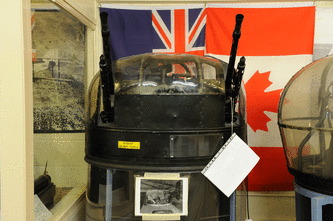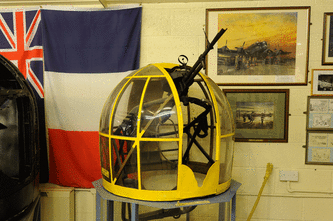Yorkshire Air Museum
Air Gunners Exhibition
From the very outset of hostilities RAF bombers took the war to Germany, often in ill equipped and outdated aircraft. This did not deter their gallant crews who faced formidable odds, especially in the early days where losses were heavy. As aircraft design improved, defensive armament did not keep pace. It was known before the war that the Browning .303” machine gun lacked the range and hitting power to bring down modern armoured fighter aircraft. As early as 1939 when Wellingtons took on Messerschmitt Bf 109’s at the Battle of Heligoland Bight, it was clear that the bombers could not defend themselves. It was envisaged that bombers flying in close formation could provide mutual protection from their powered operated gun turrets. This was not the casein practice, cannon armed fighters could simply stay out of range of the .303’s and attack from a distance. This signalled the end of the daylight bomber campaign and the move to the cover of darkness. It was not until much later in the war that rear turrets were fitted with 0.5” machine guns which offered increased range and hitting power. It was often said that the most effective gun for bomber defense was the 20mm cannon. However, this would have increased weight and decreased bomb load. It was not until after the wars end that 20mm cannon were fitted to aircraft such as the Avro Lincoln and Shackleton.
Bombing by night brought its own issues with a loss of accuracy and navigational issues. As the war progressed, night fighters were equipped with ever more sophisticated radar equipment which meant many bombers were often shot down without ever seeing by whom. A particularly nasty form of attack was the use of Schrage Music. This was where a night fighter flew undetected beneath the bomber and fired 30mm cannons vertically into the aircrafts fuel tanks. Trials of downward firing machine guns fitted to bombers were abandoned many years before as ineffective. This was a serious omission at this stage of the aerial war.
The crew members who could make a difference to this scenario were the air gunners. Their look out could often mean the difference of life and death to their fellow crew members if they could spot a night fighter before it could attack. The yell of “Corkscrew” would be shouted if a night fighter was seen which would send the bomber into a series of banks and turns, that in a word were violent.
The life expectancy of rear gunners was far less than that of other crew members as they were likely to be the first to be taken out in any fighter attack. However, every night the gunners would sit in their cold, cramped turrets staring out into the night trying to avert a potential fighter attack. Some gunners went through the war without ever firing a shot as to do so was to give away the bombers position. Others brought down a number of enemy night fighters.
The Yorkshire Air Museum has an exhibition dedicated to the air gunner and the equipment he used. It is well worth spending some time at the exhibition, as to do so, will furnish the visitor with a far greater insight into the lives of the air gunners and what they went through during the bombing campaign.
Bombing by night brought its own issues with a loss of accuracy and navigational issues. As the war progressed, night fighters were equipped with ever more sophisticated radar equipment which meant many bombers were often shot down without ever seeing by whom. A particularly nasty form of attack was the use of Schrage Music. This was where a night fighter flew undetected beneath the bomber and fired 30mm cannons vertically into the aircrafts fuel tanks. Trials of downward firing machine guns fitted to bombers were abandoned many years before as ineffective. This was a serious omission at this stage of the aerial war.
The crew members who could make a difference to this scenario were the air gunners. Their look out could often mean the difference of life and death to their fellow crew members if they could spot a night fighter before it could attack. The yell of “Corkscrew” would be shouted if a night fighter was seen which would send the bomber into a series of banks and turns, that in a word were violent.
The life expectancy of rear gunners was far less than that of other crew members as they were likely to be the first to be taken out in any fighter attack. However, every night the gunners would sit in their cold, cramped turrets staring out into the night trying to avert a potential fighter attack. Some gunners went through the war without ever firing a shot as to do so was to give away the bombers position. Others brought down a number of enemy night fighters.
The Yorkshire Air Museum has an exhibition dedicated to the air gunner and the equipment he used. It is well worth spending some time at the exhibition, as to do so, will furnish the visitor with a far greater insight into the lives of the air gunners and what they went through during the bombing campaign.
Photos in this gallery - Boulton Paul MKVIII Type A Turret - Fraser Nash 150 Mark 1 - Mid Upper Turret - Fraser Nash 120 Rear Turret - Fraser Nash FN-5 Front Turret - Armstrong Whitworth Turret With Vickers K Machine Gun





